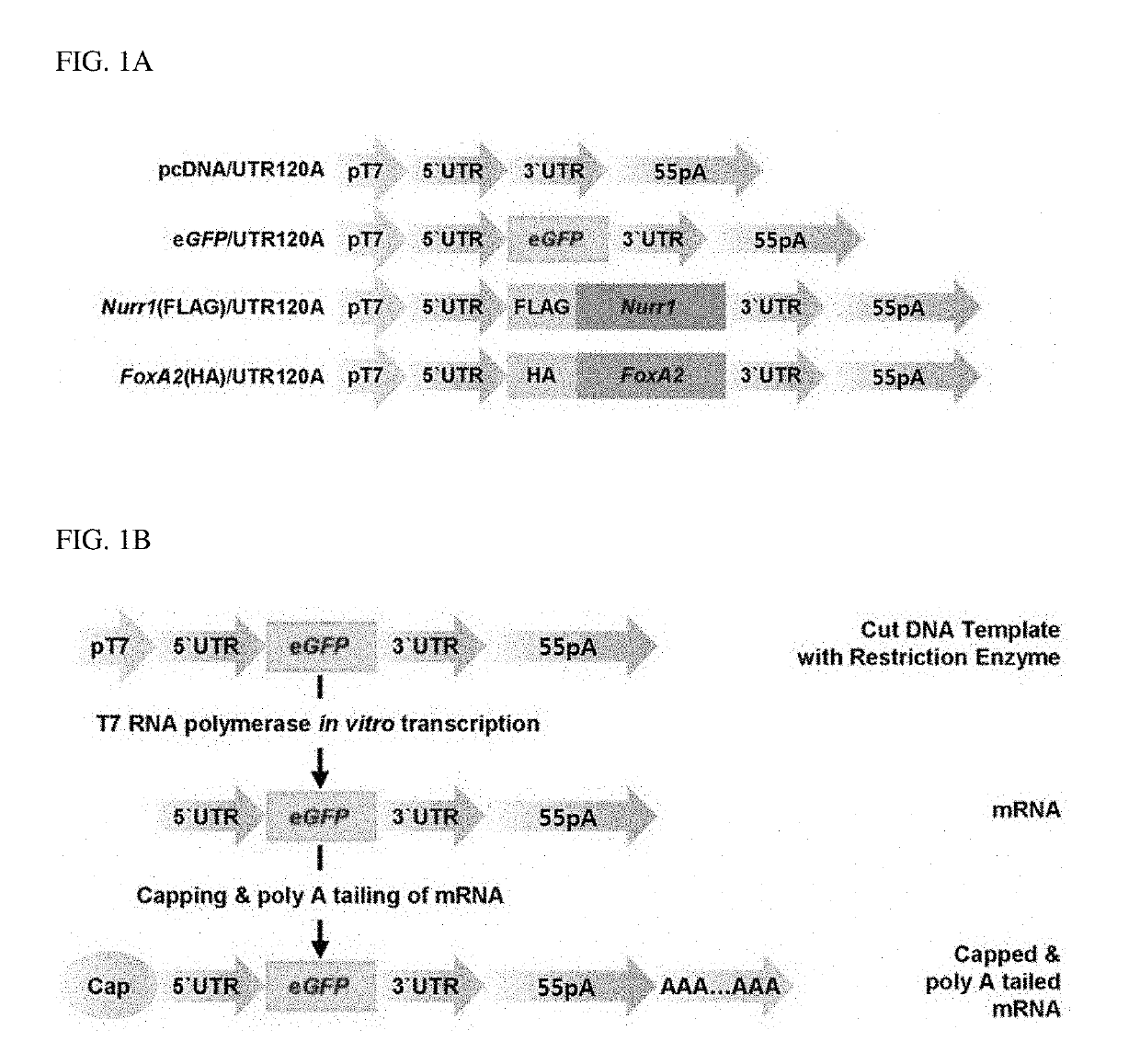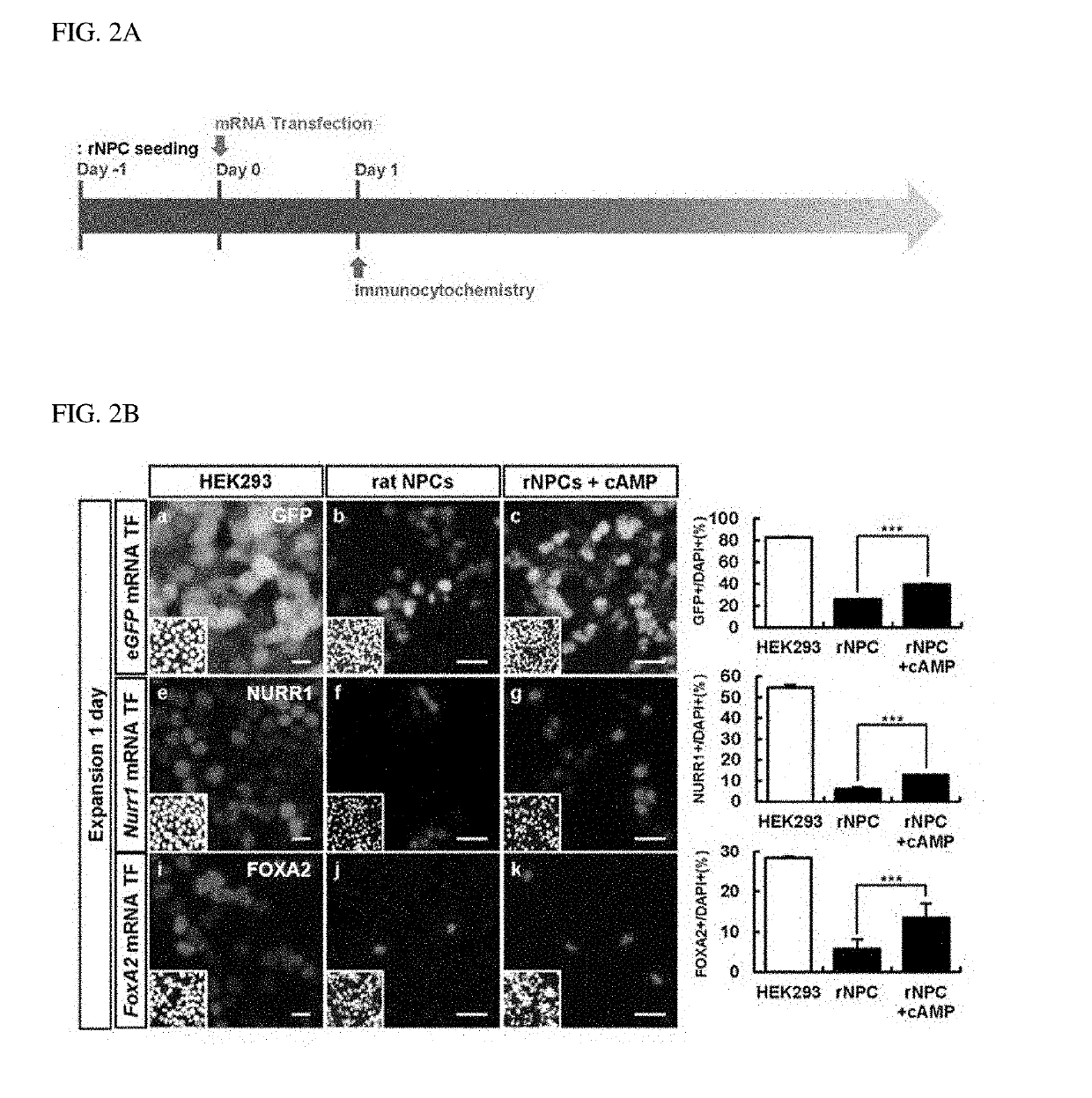Method of differentiating neural stem cells or neural precursor cells into dopamine neurons
a neural stem cell and neural precursor technology, applied in the field of neural stem cells or neural precursor cells into dopamine neurons, can solve the problems of ethical and technical problems, unsuitability for clinical application, risk of genetic modification and mutagenesis, etc., and achieve the effect of efficient and stable differentiation of neural stem cells
- Summary
- Abstract
- Description
- Claims
- Application Information
AI Technical Summary
Benefits of technology
Problems solved by technology
Method used
Image
Examples
example 1
tal Preparation and Experimental Methods
[0056]1-1. Isolation of Rat Neural Precursor Cells (Rat NPCs)
[0057]Experimental animals were raised and treated according to the Institutional Animal Care and Use Committee (IACUC, 2016-0194A) guidelines of Hanyang University. Rat neural precursor cells (NPCs) were obtained from the cortex of Sprague-Dawley (SD) rat embryos at an embryonic age of 14.5 days (DaeHan BioLink). Subsequently, rat NPCs isolated from the rat cortex tissues were cultured on a culture dish coated with 15 mg / mL poly-L-ornithine (PLO, Sigma-Aldrich) and 1 mg / mL fibronectin (FN, Sigma-Aldrich) at 37° C. and 5% CO2.
[0058]Next, the rat NPCs were allowed to proliferate in a N2 medium supplemented with 20 ng / mL of a basic fibroblast growth factor (bFGF, R&D Systems), and to differentiate in a N2 medium supplemented with 0.2 mM ascorbic acid (Sigma-Aldrich), 20 ng / mL of a brain-derived neurotrophic factor (BDNF, R&D Systems), 20 ng / mL of a glial cell line-derived neurotrophic ...
example 2
ion of Protein Expression by Intracellular Transfection of Synthetic mRNA of Dopamine Neuron-Inducing Transcription Factor
[0079]To differentiate the rat cerebral cortex-derived NPCs isolated using the method of Example 1-1 into dopamine neurons, the inventors of the present invention intended to synthesize mRNA of a dopamine neuron-inducing transcription factor as a means for protein expression of the transcription factor and transfect the synthetic mRNA into the rat NPCs.
[0080]For this, first, to synthesize mRNA that stably expresses a dopamine neuron-inducing transcription factor, plasmid DNAs having a structure illustrated in FIG. 1A were constructed. In particular, each plasmid DNA included a T7 promoter (pT7) for in vitro transcription, UTR (5′UTR and 3′UTR) and a poly A tail (55 pA) for the stability of mRNA, and genes to be expressed (control: eGFP, dopamine neuron-inducing transcription factor: Nurr1 or FoxA2). The plasmid DNAs having the above-described structure have a lin...
example 3
ion of Protein Expression Maintenance in Cells According to Synthetic mRNA Transfection
[0083]In addition to the results of Example 2, to verify whether protein expression was maintained by intracellularly transfected mRNA, mRNA of Nurr1, which is a dopamine neuron-inducing transcription factor, was transfected into rat NPCs in the same manner as in Example 2, and then protein expression levels were observed for a differentiation period of 1 day to 3 days (diff. 1 to diff. 3) as illustrated in FIG. 3A.
[0084]As a result, as illustrated in FIG. 3B, it was confirmed that, when observed until differentiation day 3 (diff. 3), the expression of the Nurr1 protein, which is a dopamine neuron-inducing transcription factor, was maintained only for about 1 day to about 2 days due to rapid degradation of mRNA in cells.
[0085]To address this problem, as illustrated in FIG. 4A, the inventors of the present invention repeatedly transfected rNPCs with Nurr1 mRNA at intervals of 1 day so that protein ...
PUM
| Property | Measurement | Unit |
|---|---|---|
| temperature | aaaaa | aaaaa |
| time | aaaaa | aaaaa |
| temperature | aaaaa | aaaaa |
Abstract
Description
Claims
Application Information
 Login to View More
Login to View More - R&D
- Intellectual Property
- Life Sciences
- Materials
- Tech Scout
- Unparalleled Data Quality
- Higher Quality Content
- 60% Fewer Hallucinations
Browse by: Latest US Patents, China's latest patents, Technical Efficacy Thesaurus, Application Domain, Technology Topic, Popular Technical Reports.
© 2025 PatSnap. All rights reserved.Legal|Privacy policy|Modern Slavery Act Transparency Statement|Sitemap|About US| Contact US: help@patsnap.com



